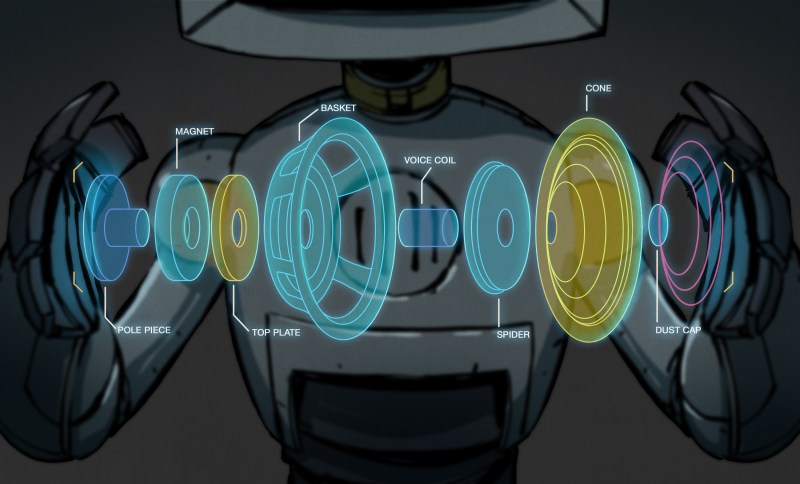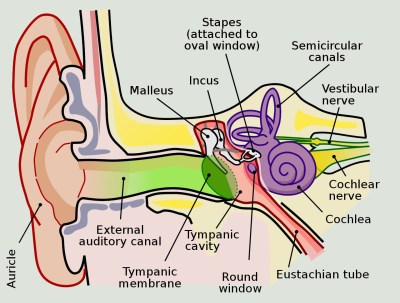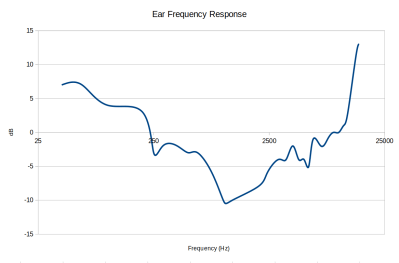THE ANONYMOUS

A lot of our projects make noise. It can be something as simple as a microcontroller driving a small speaker or a truly ambitious Hi-Fi project, but common to all of them is the desire to get that sound out in as audible and high-quality a manner as possible. We’ve been known to make fun of the more preposterous side of the Hi-Fi world at times, but behind it all there’s a basis of solid and provable audio engineering that can be brought to bear on almost any project involving sound and electronics. Perhaps it’s time to devote some time to a series exploring the topic, and what better place to start than the ultimate destination for all that sound. Any Hi-Fi is only as good as the ears of the person listening to it, so in out journey through the world of audio that’s where we’ll start.
The Most Beautiful Piece Of Audio Equipment You Own

A diagram of the three main zones containing the inner workings of the human ear will no doubt be familiar to any Hackaday reader who has sat through a high school biology class. There’s the outer ear which we’re all used to seeing in the mirror, behind that is the middle ear, and further inside the inner ear.
The outer ear and canal are more than just an odd-shaped bodily accoutrement, instead they’re a sound reflector designed to catch sounds and channel them to the ear canal which channels sound to the middle ear. They have a frequency response all of their own, resulting in a peak for most people somewhere around 3.5 kHz. At the end of the ear canal is the tympanic membrane, a diaphragm that vibrates with the sound and transmits it to the structures in the middle ear. Behind the tympanic membrane are a set of three small bones that form a lever system which transfers the vibrations through another membrane to the liquid-filled inner ear. Their function is described as impedance matching, ensuring that the vibrations are transmitted to the liquid at the correct amplitude. A system of muscles in the inner ear act as a gain control, allowing the ear to desensitise itself and protect the inner ear from very loud noises. Finally in the liquid-filled inner ear are a set of spiral tubes with nerve endings that sense the pressure changes of the sound, and transmit the information to the brain.

This beautiful and intricate mechanism has to last a lifetime, and over that time it suffers from both ageing, and whatever wear and tear life throws at it. When I was a youngster I could hear the 15.625 kHz whine of a 625-line CRT TV set in operation or the squeak of bats catching insects on a summer’s evening, but now I can’t. As I’ve aged, my tympanic membrane and other ear parts have become stiffer, meaning that like almost everyone over the age of about 20, I can’t hear those high frequencies any more.
Similarly, any ear damage from loud noises or disease affects hearing performance, so if you had a fondness for live heavy metal, then your hearing has probably suffered. I’m fortunate as someone who was in the right place at the right time do sound and light engineering at more than a few raves back in the day, that I had the sense to wear those little foam ear plugs. My generation’s version of the old 1960s joke is that if you can remember 1990 you weren’t really there man, but at least my ears can’t remember it and I don’t have to live with tinnitus.
How Much Listening Pleasure Has Father Time Taken Away?

The point of all this is that while a five-year-old with no hearing problems has near-perfect hearing, those of us who are old enough to pursue Hi-Fi are not so lucky. Age has degraded our hearing, but the question is, by how much? It was time to characterise my ears, and for that after fooling around with a signal generator for a while I found a much better way to do that using recordings of sound at gradated amplitude intervals. It allows a graph to be generated showing the minimum audible sound level at a given frequency, and while the results should perhaps be taken with a pinch of salt because they rely on uncalibrated equipment they do at least give a useful picture of hearing bandwidth.
The lowest frequency I could hear at all with the signal generator was around 30 Hz, while I had difficulty in hearing much above 16 kHz. This is pretty normal for someone of my age, and it seems those foam ear plugs saved me from too much damage at the hands of The Shamen, KLF, or Human Resource. It shows how those bats around 20 kHz and above that I could hear as a youngster are now an impossibility to hear. The curve backs this up, with a few lumps and bumps in the middle that may reflect my headphones as much as me.
The Point Of All This Aural Musing
Talking about ears is very interesting stuff and I’d like to invite you all to plot your own response curves in the same way, but the real reason for going through all this is to remind readers that the best audio equipment in the world is not going to improve the listening ability of their ears. Unless you are a five-year-old child, the weakest point in any listening chain is located on the side of your head, and once that has been understood then the process of audio design becomes one of presenting your ears with the best quality audio within their parameters rather than trying to give them something they simply aren’t capable of resolving. Something to bear in mind, should you fall too far down the Hi-Fi rabbit hole.
All that sound has to reach those ears somehow, so to continue this series we’ll be looking at the next link in the chain. Loudspeakers are the single component that can bring out the best in an inexpensive audio set-up or ruin the sound of a good one, and we’ll be examining their design and construction from a tech perspective to help you you discern the good from the bad, and to make your own creations as good as they can be.
from Hackaday https://ift.tt/3vLBWok
No comments: